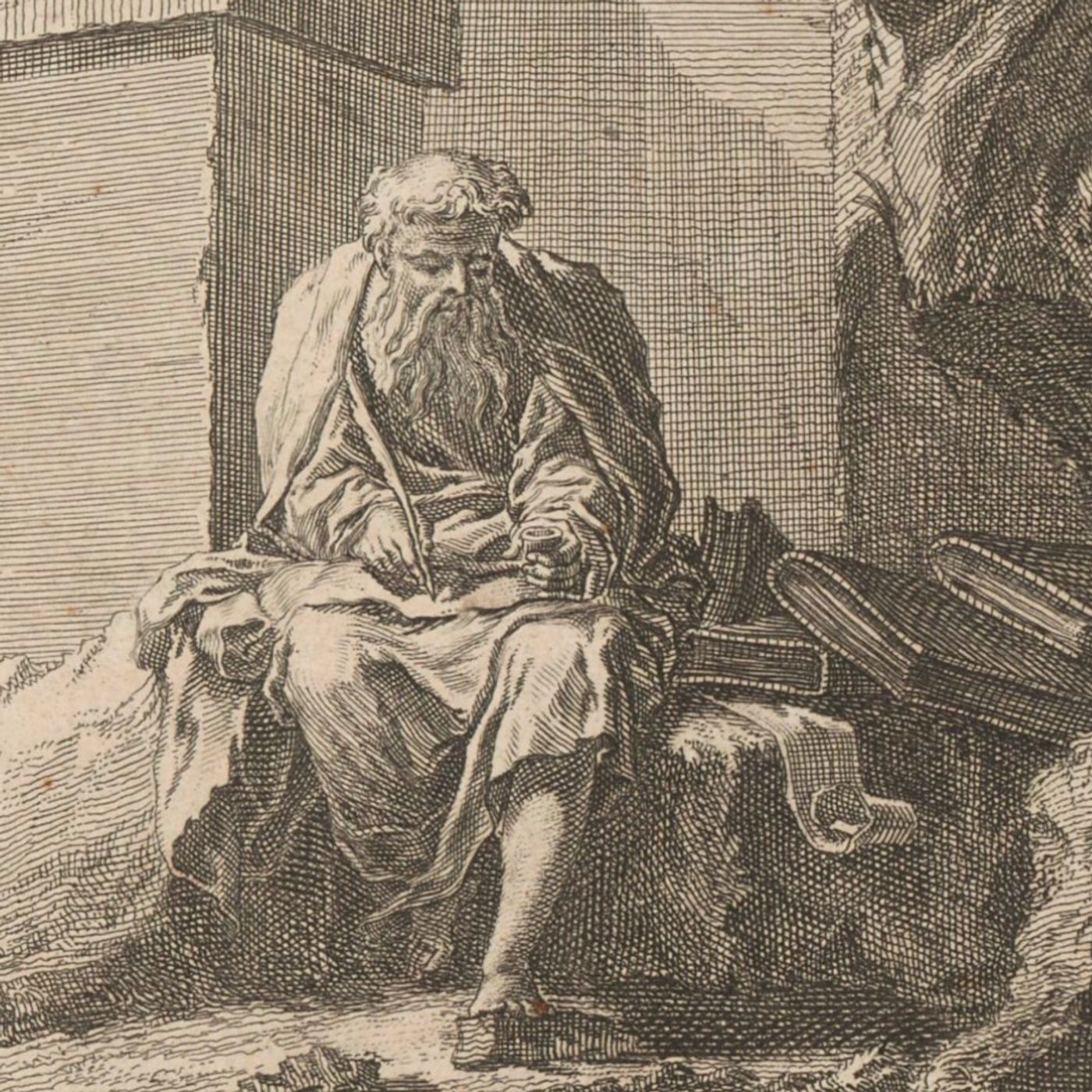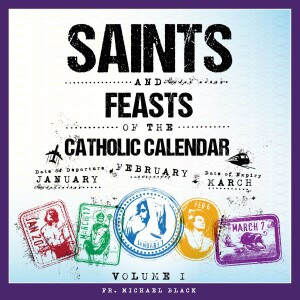
June 9: Saint Ephrem, Deacon and Doctor
Early Fourth Century–373
Optional Memorial; Liturgical Color: White
Patron Saint of spiritual directors
The Harp of the Holy Spirit
The Councils of Ephesus in 431 and Chalcedon in 451 ended a centuries-long scorpion dance. Bishops, theologians, and scholars from Egypt to Syria had long circled one another with suspicion, stinging their enemies with sharp words and pointed tongues. Did Jesus Christ have one or two natures? If two natures, were they joined in His will or in His person? If united in His person, at conception? Was He one person or was He two? Smart, educated men defended every shade of every subtlety of every complex question with all of their considerable skill. The answers hacked out at Ephesus and Chalcedon, whose hurly-burly political intrigues were less than inspiring, answered the relevant questions definitively, establishing orthodox teaching for all time. The theological language coined during those fifth century debates is still familiar to the Church today: hypostatic union, monophysitism, Theotokos, etc.
Today’s saint, Ephrem, was active a century prior to the great conclusions and clarifications of the fifth-century Councils. Although Ephrem did not deviate from what later Councils would explicitly teach, he used far different language to communicate the same truths, anticipating later teachings through poetry. Saint Ephrem was a poet and a musician first and foremost. His language is more beautiful, compelling, and memorable because it is metaphorical. Exactness in words risks dryness. You can say that the average density of the air in the ship’s hull eventually equaled the average density of the surrounding water. Or you can say that the ship sank like a stone to the ocean floor. You can write that a day’s high dew point caused the air’s water vapor content to slow evaporation. Or you can write that it was so hot and humid that people melted like candles. The Church can teach that we eat Christ’s body and blood in the Holy Eucharist. Or we can speak directly to Christ with the poet Ephrem and say, “In your bread hides the Spirit who cannot be consumed; in your wine is the fire that cannot be swallowed. The Spirit in your bread, fire in your wine: behold a wonder heard from our lips.”
The Councils of Ephesus and Chalcedon taught that the one person of Jesus Christ united in Himself a fully divine nature and a fully human nature from the moment of His conception. Saint Ephrem wrote “The Lord entered (Mary) and became a servant; the Word entered her, and became silent within her; thunder entered her and his voice was still; the Shepherd of all entered her and became a Lamb…” Poetry, metaphor, paradox, images, song, and symbols. These were tools in Saint Ephrem’s nimble hands. Theology for him was liturgy, music, and prayer. He was called the Harp of the Holy Spirit, the Sun of the Syrians, and the Column of the Church by his admirers, who included luminaries such as Saints Jerome and Basil.
Saint Ephrem was a deacon who declined ordination to the priesthood. He lived radical poverty, wearing a patched and dirty tunic. He had a cave for his home and a rock for his pillow. Ephrem founded a theological school and was deeply involved in catechesis through preaching, liturgy, and music. He died after contracting a disease from a patient he was caring for. Saint Ephrem is the Church’s greatest Syriac language writer, proof that Christianity is not synonymous with the West or European culture. Ephrem’s world thrived for centuries with its own unique Semitic identity in today’s Syria, Iraq, Iran, and India. Saint Ephrem’s Syria was not the “Near East,” as Europeans later called the region. To him, it was just home, the deep cradle of the new way of loving God that was, and is, Christianity. Saint Ephrem was declared a Doctor of the Church by Pope Benedict XV in 1920.
Saint Ephrem, you wrote tenderly and lovingly about the truths of our faith. Help all Christian artists to stay true to the Truth and to communicate Jesus Christ to the world through beauty, music, and images that raise the mind and lift the heart to God Himself.
view more
Early Fourth Century–373
Optional Memorial; Liturgical Color: White
Patron Saint of spiritual directors
The Harp of the Holy Spirit
The Councils of Ephesus in 431 and Chalcedon in 451 ended a centuries-long scorpion dance. Bishops, theologians, and scholars from Egypt to Syria had long circled one another with suspicion, stinging their enemies with sharp words and pointed tongues. Did Jesus Christ have one or two natures? If two natures, were they joined in His will or in His person? If united in His person, at conception? Was He one person or was He two? Smart, educated men defended every shade of every subtlety of every complex question with all of their considerable skill. The answers hacked out at Ephesus and Chalcedon, whose hurly-burly political intrigues were less than inspiring, answered the relevant questions definitively, establishing orthodox teaching for all time. The theological language coined during those fifth century debates is still familiar to the Church today: hypostatic union, monophysitism, Theotokos, etc.
Today’s saint, Ephrem, was active a century prior to the great conclusions and clarifications of the fifth-century Councils. Although Ephrem did not deviate from what later Councils would explicitly teach, he used far different language to communicate the same truths, anticipating later teachings through poetry. Saint Ephrem was a poet and a musician first and foremost. His language is more beautiful, compelling, and memorable because it is metaphorical. Exactness in words risks dryness. You can say that the average density of the air in the ship’s hull eventually equaled the average density of the surrounding water. Or you can say that the ship sank like a stone to the ocean floor. You can write that a day’s high dew point caused the air’s water vapor content to slow evaporation. Or you can write that it was so hot and humid that people melted like candles. The Church can teach that we eat Christ’s body and blood in the Holy Eucharist. Or we can speak directly to Christ with the poet Ephrem and say, “In your bread hides the Spirit who cannot be consumed; in your wine is the fire that cannot be swallowed. The Spirit in your bread, fire in your wine: behold a wonder heard from our lips.”
The Councils of Ephesus and Chalcedon taught that the one person of Jesus Christ united in Himself a fully divine nature and a fully human nature from the moment of His conception. Saint Ephrem wrote “The Lord entered (Mary) and became a servant; the Word entered her, and became silent within her; thunder entered her and his voice was still; the Shepherd of all entered her and became a Lamb…” Poetry, metaphor, paradox, images, song, and symbols. These were tools in Saint Ephrem’s nimble hands. Theology for him was liturgy, music, and prayer. He was called the Harp of the Holy Spirit, the Sun of the Syrians, and the Column of the Church by his admirers, who included luminaries such as Saints Jerome and Basil.
Saint Ephrem was a deacon who declined ordination to the priesthood. He lived radical poverty, wearing a patched and dirty tunic. He had a cave for his home and a rock for his pillow. Ephrem founded a theological school and was deeply involved in catechesis through preaching, liturgy, and music. He died after contracting a disease from a patient he was caring for. Saint Ephrem is the Church’s greatest Syriac language writer, proof that Christianity is not synonymous with the West or European culture. Ephrem’s world thrived for centuries with its own unique Semitic identity in today’s Syria, Iraq, Iran, and India. Saint Ephrem’s Syria was not the “Near East,” as Europeans later called the region. To him, it was just home, the deep cradle of the new way of loving God that was, and is, Christianity. Saint Ephrem was declared a Doctor of the Church by Pope Benedict XV in 1920.
Saint Ephrem, you wrote tenderly and lovingly about the truths of our faith. Help all Christian artists to stay true to the Truth and to communicate Jesus Christ to the world through beauty, music, and images that raise the mind and lift the heart to God Himself.
More Episodes
January 24: Saint Francis de Sales, Bishop
 2024-01-23
2024-01-23
 2024-01-23
2024-01-23
January 22: Saint Vincent, Deacon and Martyr
 2024-01-22
2024-01-22
 2024-01-22
2024-01-22
January 21: Saint Agnes, Virgin and Martyr
 2024-01-19
2024-01-19
 2024-01-19
2024-01-19
January 20: Saint Sebastian, Martyr
 2024-01-18
2024-01-18
 2024-01-18
2024-01-18
January 20: Saint Fabian, Pope and Martyr
 2024-01-16
2024-01-16
 2024-01-16
2024-01-16
January 13: Saint Hilary, Bishop and Doctor
 2024-01-08
2024-01-08
 2024-01-08
2024-01-08
January 7: Saint Raymond of Peñafort, Priest
 2024-01-07
2024-01-07
 2024-01-07
2024-01-07
The Epiphany of the Lord: January 7, 2024
 2024-01-06
2024-01-06
 2024-01-06
2024-01-06
January 3: The Most Holy Name of Jesus
 2024-01-02
2024-01-02
 2024-01-02
2024-01-02
December 31: Saint Sylvester I, Pope
 2023-12-30
2023-12-30
 2023-12-30
2023-12-30
012345678910111213141516171819
Create your
podcast in
minutes
- Full-featured podcast site
- Unlimited storage and bandwidth
- Comprehensive podcast stats
- Distribute to Apple Podcasts, Spotify, and more
- Make money with your podcast
It is Free
- Privacy Policy
- Cookie Policy
- Terms of Use
- Consent Preferences
- Copyright © 2015-2024 Podbean.com






